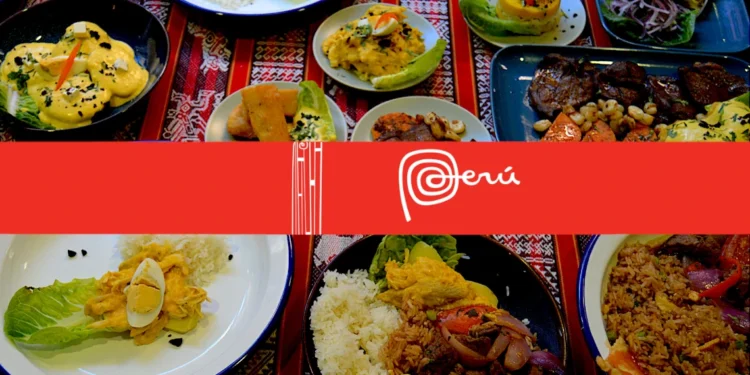Peruvian cuisine is not just a collection of recipes; it’s a journey filled with stories, cultures, and traditions passed down from generation to generation. It’s an art form that originates in the cradle of the Andes, enriched by influences from Africa, Asia, and Europe, and constantly reinvented to conquer the world.
At the heart of this extraordinary gastronomy are its ingredients—many of which are unknown outside of Peru but are essential to creating the flavors that captivate millions. In this article, we will take you on a tour of seven emblematic ingredients of Peruvian cuisine. From the Andean fields to tables around the world, each one has a story to tell and a flavor to experience.
Whether you live in the Netherlands or anywhere else in the world, you’ll discover that many of these ingredients are already within your reach, ready to transform your dishes into an unforgettable experience.
1. Quinoa: The Golden Grain of the Andes
Quinoa is an ancient grain that has been cultivated in the Andes for over 5,000 years, particularly in countries like Peru, Bolivia, and Ecuador. Known by Andean people as “the mother of all grains,” quinoa was considered sacred by the Incas, who used it in religious ceremonies and regarded it as a gift from the gods. After being almost forgotten for centuries, quinoa has recently resurfaced as a global superfood due to its exceptional nutritional properties.
Nutritional Value and Flavor
Quinoa is a grain rich in protein, fiber, and essential minerals such as iron, magnesium, and zinc. It is known as a complete source of plant-based protein, meaning it contains all nine essential amino acids, making it especially valuable for vegetarian or vegan diets. Additionally, it is gluten-free, making it an ideal option for those with gluten intolerance.
In terms of flavor, quinoa has a mild, slightly nutty taste, making it versatile for a variety of dishes, from salads to stews and soups.
Where to Use It?
Quinoa can be used in a wide variety of Peruvian dishes, taking advantage of its light texture and ability to absorb flavors. Here are some typical dishes that use quinoa:
- Quinoa Soup: A delicious Peruvian broth that combines quinoa with vegetables, chicken, or meat, perfect for chilly Andean nights.
- Quinoa Salad: A fresh and healthy option combining quinoa with fresh vegetables, cheese, and dressings, ideal as a main dish or side.
- Quinoa Rice: A healthy substitute for traditional rice, mixed with ingredients like vegetables, meat, and herbs, perfect as a side dish.
Where to Find It and Why Use It?
Quinoa is available in natural product supermarkets or Latin stores, both as grain and flour. You should consider it a key ingredient in your diet due to its high nutritional value, versatility, and its ability to replace other grains in your daily recipes.
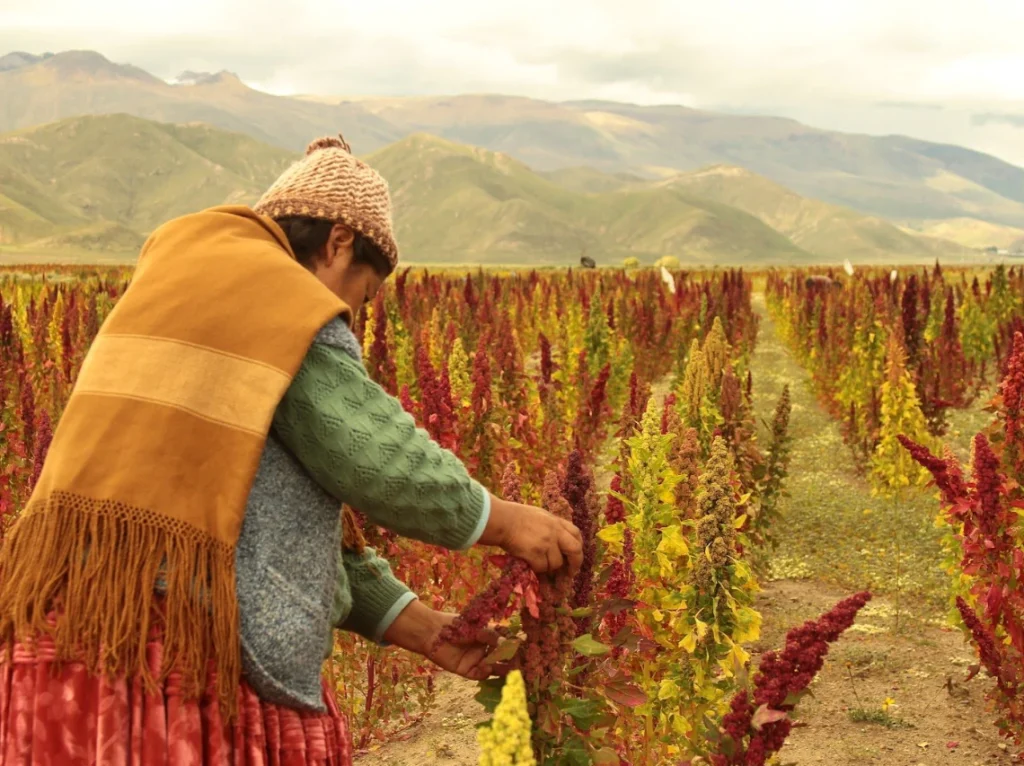
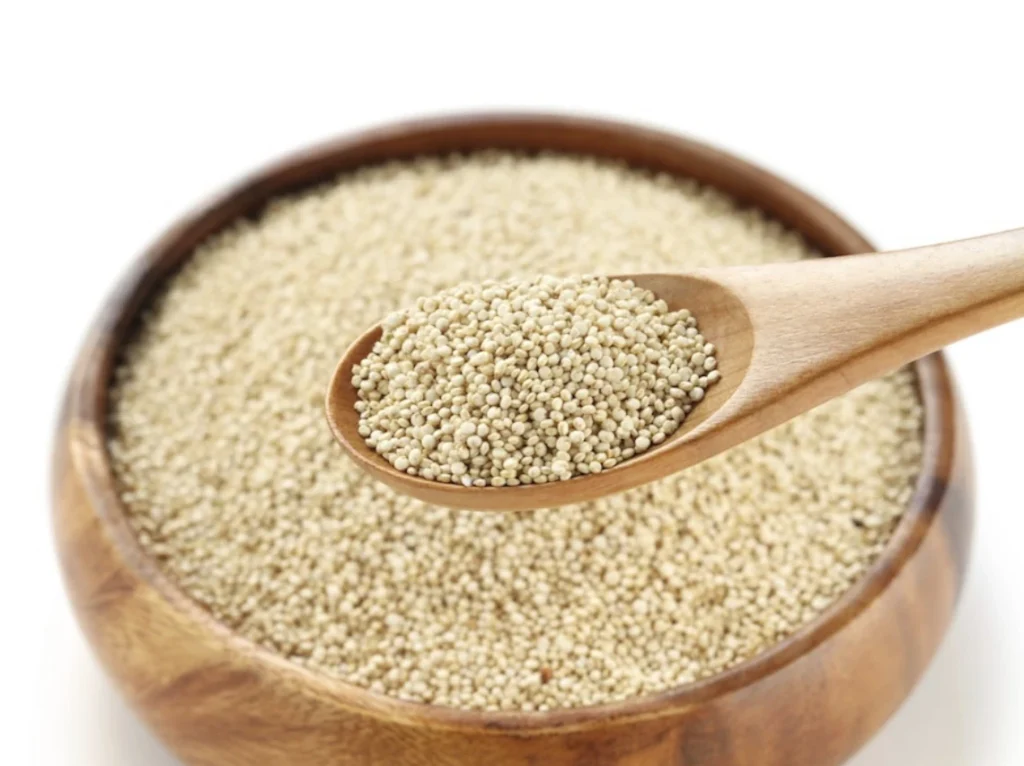
2. Potato: The Potato of All Potatoes
The potato is undoubtedly one of the most iconic ingredients in Peruvian cuisine. Native to the Andean region, it was first cultivated in what is now Peru over 7,000 years ago. For the Andean people, the potato was an essential food and a core part of their daily diet. It was a crop that allowed civilizations like the Inca to thrive, as they grew more than 4,000 varieties of potatoes. Today, Peru remains home to the world’s greatest diversity of potatoes.
Nutritional Value and Flavor
The potato is rich in complex carbohydrates, making it an excellent source of energy. It also contains vitamins like C and several B vitamins, as well as minerals such as potassium and magnesium. While often perceived as a heavy food, potatoes are a highly versatile ingredient that adapts to various dietary needs, from boiled to baked potatoes.
In terms of flavor, potatoes have a mild taste that can vary depending on the variety: some are sweet, others are saltier, but they always have a creamy texture when cooked properly.
Where to Use It?
The potato is an indispensable ingredient in Peruvian cuisine. Here are a few traditional dishes that feature this beloved tuber:
- Causa Rellena: A cold layered dish that combines mashed yellow potato, yellow chili, and a filling of chicken or tuna, all perfectly seasoned.
- Papas a la Huancaína: Boiled potatoes smothered in a creamy sauce made with yellow chili, fresh cheese, and milk, a classic Peruvian appetizer.
- Papas con Carne: A traditional stew with potatoes, beef, onions, tomatoes, and herbs, perfect to accompany rice.
Where to Find It and Why Use It?
Potatoes are easy to find at local supermarkets, Latin stores, or even at fresh markets. By using them, you’re not only adding a delicious and comforting food to your table but also supporting a cultural legacy that has been part of humanity for thousands of years.
If you’re in the Netherlands, vastkokende or nieuwe (baby) potatoes are excellent for recreating these dishes. A fun fact: Potatoes were brought to Europe by Spanish conquistadors in the 16th century, changing the course of global cuisine.
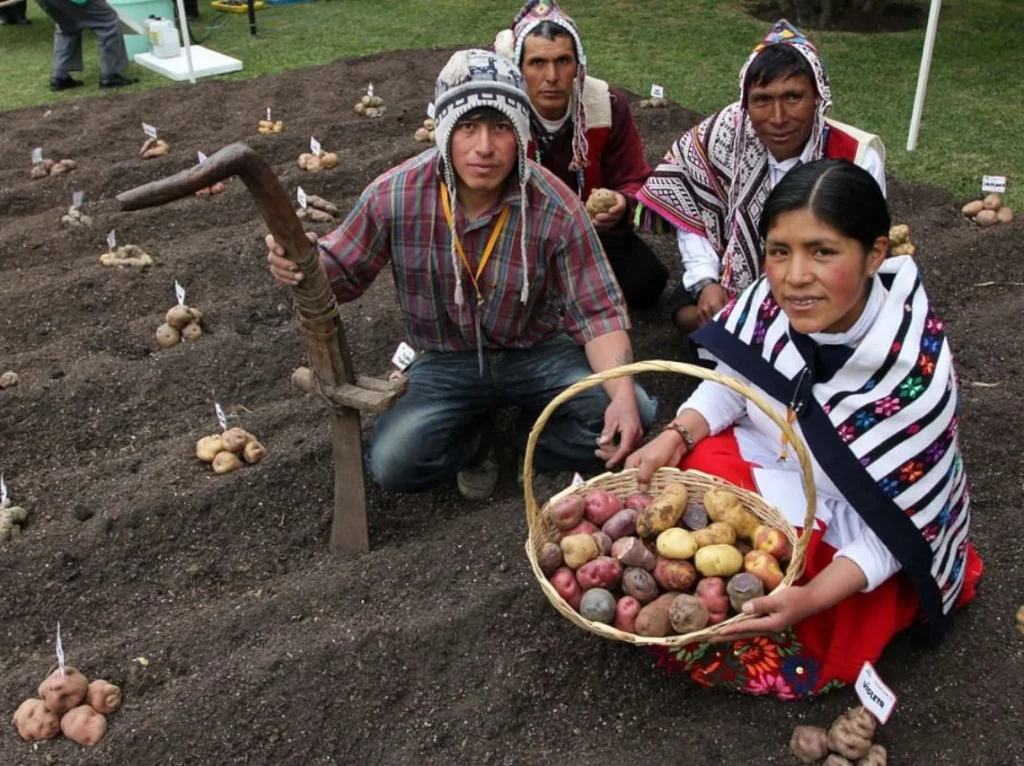
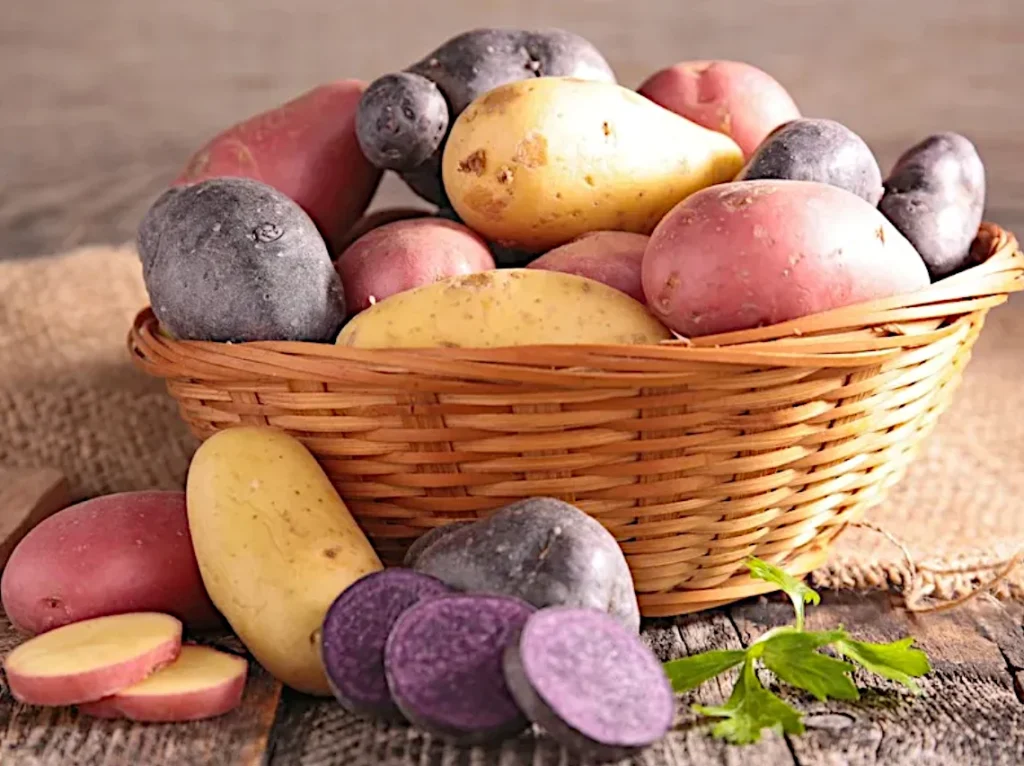
3. Yellow Chili: The Heart of Peruvian Flavors
Yellow chili, known as ají amarillo, is a variety of pepper predominantly grown in Peru, recognized for its distinct flavor and vibrant color. It is a fundamental ingredient in Peruvian cuisine and has a deep connection to the country’s gastronomic identity. Despite its moderate spiciness, yellow chili has a smoothness that makes it the base for many sauces, soups, and stews.
Nutritional Value and Flavor
Yellow chili is rich in vitamin C and antioxidants, making it a great ally for strengthening the immune system. Additionally, it contains capsaicin, the compound responsible for its heat, which has anti-inflammatory and pain-relieving properties.
Its flavor is a combination of sweet and spicy, which makes it perfect for adding complexity to dishes without overwhelming them with excessive heat. Its unique flavor is a hallmark of many Peruvian dishes.
Where to Use It?
Yellow chili is essential in many Peruvian recipes. Here are some dishes where it plays a key role:
- Ají de Gallina: A creamy chicken stew with a sauce made from yellow chili, walnuts or pecans, and soaked bread, served with white rice.
- Lomo Saltado: A Peruvian classic that combines beef, onions, tomatoes, fried potatoes, and yellow chili.
- Causa Rellena: This dish incorporates yellow chili into the mashed potato preparation, giving it a spicy and unique touch.
Where to Find It and Why Use It?
Yellow chili can be found fresh or in paste form at Latin stores, especially at supermarkets specializing in Latin American products. It is crucial in Peruvian cuisine, not only for its flavor but for its ability to transform dishes, giving them a unique touch.
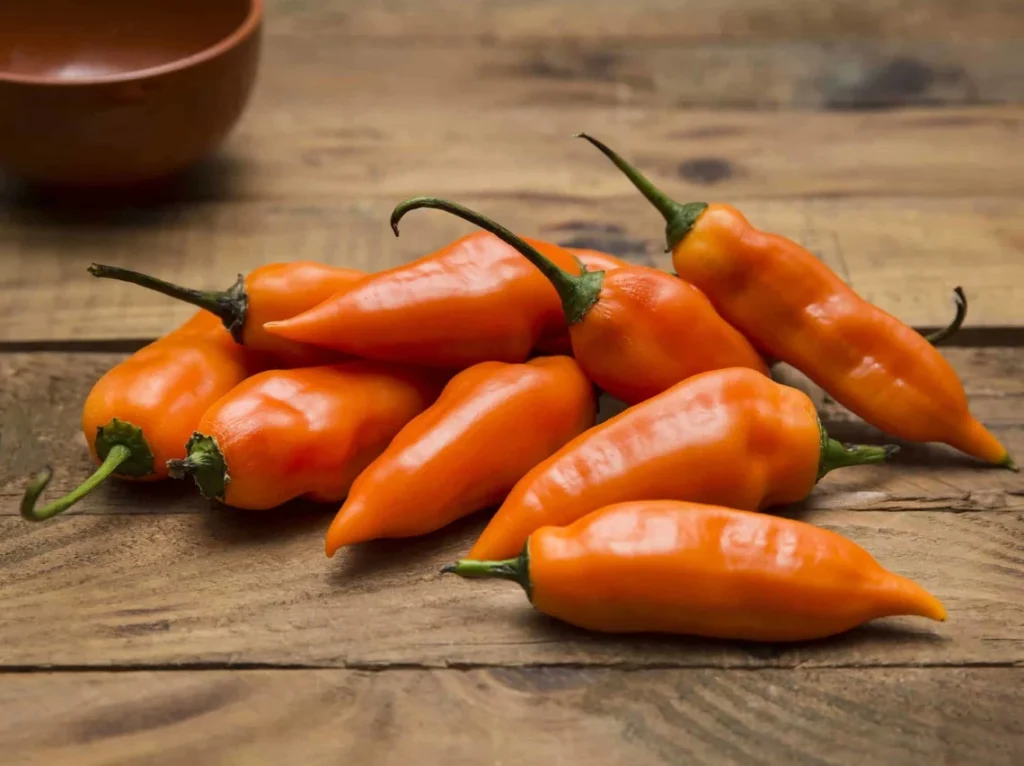

4. Sweet Potato: The Sweet Companion of the Andes
Sweet potato, also known as batata, is native to the Andean region and has been cultivated in Peru for centuries. Although it is commonly associated with other countries in the Americas, sweet potato has its deepest roots in the highlands of Peru. Ancient Peruvians valued sweet potato as much as potatoes, and both root vegetables were fundamental to their daily diet.
Nutritional Value and Flavor
Sweet potato is a rich source of complex carbohydrates and fiber. It is particularly high in vitamin A, thanks to its characteristic orange color, making it an excellent ally for eye health. It is also a good source of antioxidants that help combat cellular aging.
In terms of flavor, sweet potato has a natural sweetness that makes it ideal for both sweet and savory dishes. Its creamy texture makes it a perfect accompaniment to many stews and soups.
Where to Use It?
Sweet potato is so versatile that it is used in both desserts and savory dishes. Here are a few examples of its uses:
- Sweet Potato Mash: A smooth and sweet side dish, perfect for roasted meats or grilled dishes.
- Fried Sweet Potato: Sliced thin and fried, it makes a delicious and crunchy snack.
- Sweet Potato Tamale: In this dish, sweet potato is mixed with corn dough and cooked in banana leaves, giving it a soft texture and unique flavor.
Where to Find It and Why Use It?
You can find sweet potato in fresh markets or well-stocked supermarkets. This ingredient is not only delicious, but it also provides vital nutrients for your diet. Incorporating it into your meals will allow you to enjoy its natural sweetness while reaping health benefits.
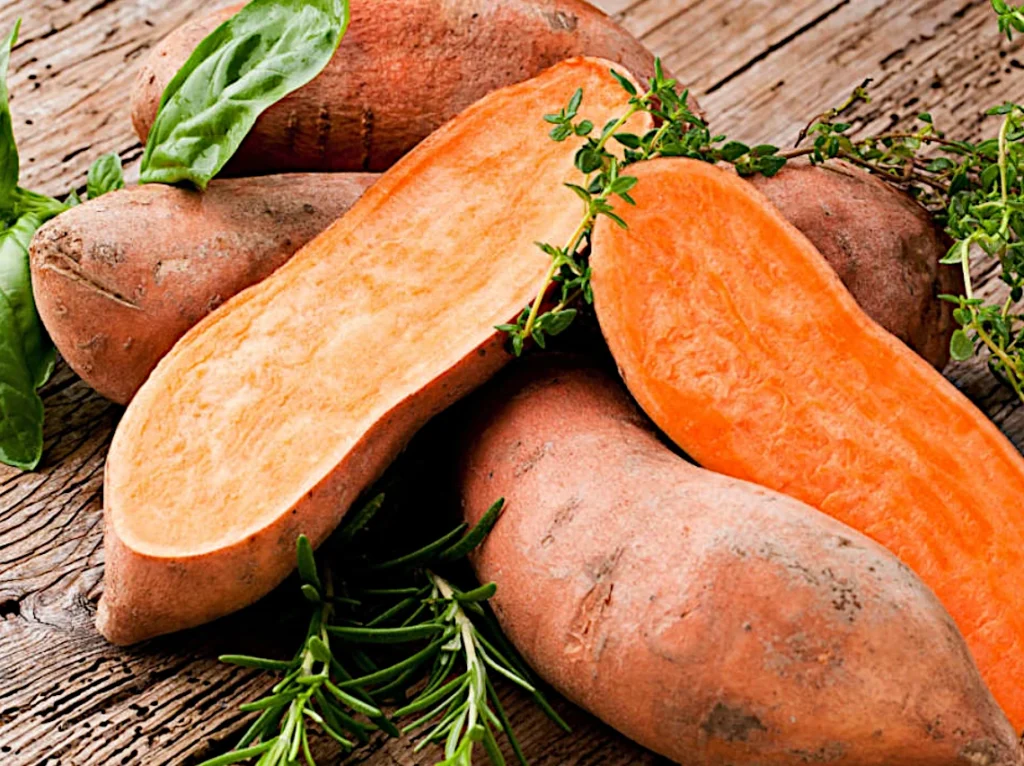
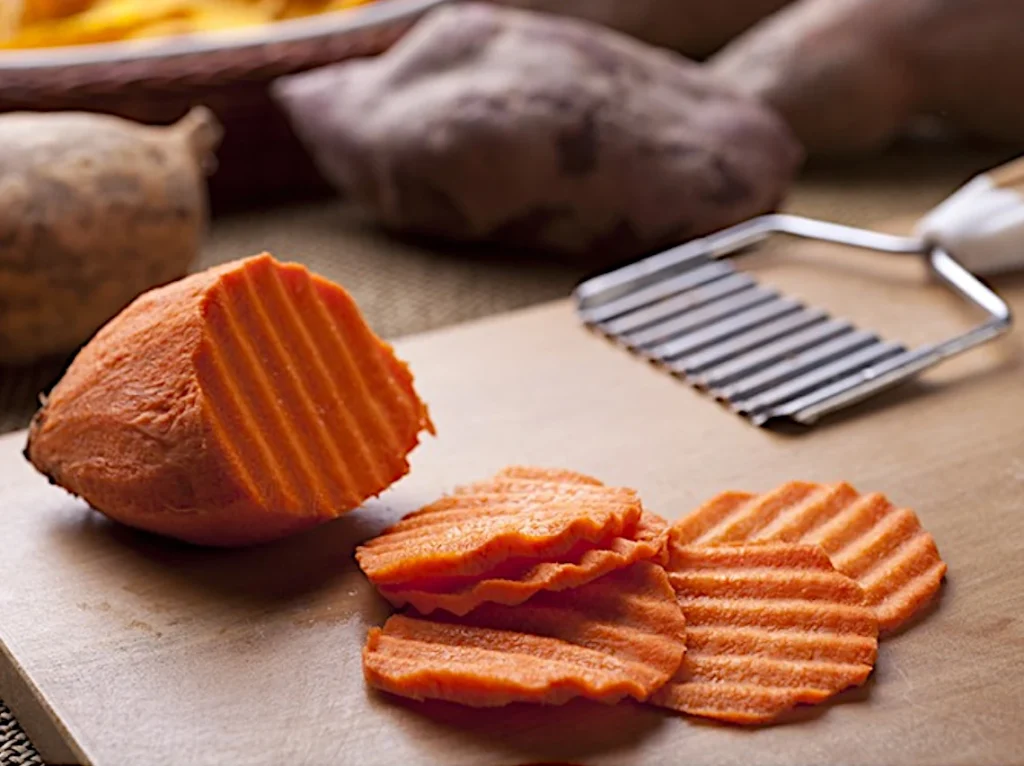
5. Culantro: The Intense Flavor of Creole Cuisine
Culantro, known as Eryngium foetidum, is an herb native to Central and South America. Although it should not be confused with cilantro, culantro has a much stronger flavor and is an essential ingredient in Peruvian cuisine. In rural areas of Peru, culantro has been used for centuries to flavor stews, soups, and sauces. Its presence in Peruvian gastronomy is so important that it is a key element in dishes such as seco de carne (beef stew) and ceviche.
Nutritional Value and Flavor
Culantro is an excellent source of vitamins A, C, and K, and has antioxidant properties that contribute to overall health. Additionally, it is known for its ability to aid digestion and its anti-inflammatory properties.
In terms of flavor, culantro is highly aromatic with a stronger, earthier taste compared to cilantro, featuring slightly spicy notes. Its flavor is most intense when fresh, making it a unique ingredient for adding depth to dishes.
Where to Use It?
Culantro is used in a variety of Peruvian dishes. Here are a few examples:
- Seco de Carne: A thick stew made with beef or lamb, cooked with culantro, aji (chili), and other herbs.
- Ceviche: Although cilantro is the star of ceviche, culantro is used as a complement to add a stronger, refreshing note.
- Aguadito de Pollo: A Peruvian soup made with rice, chicken, aji amarillo, and culantro, perfect for colder seasons.
Where to Find It and Why Use It?
Culantro can be difficult to find fresh in some places, but it can be found in specialized Latin stores. Using culantro in cooking not only enhances the flavor of dishes but also adds a nutritious boost that is beneficial for health.
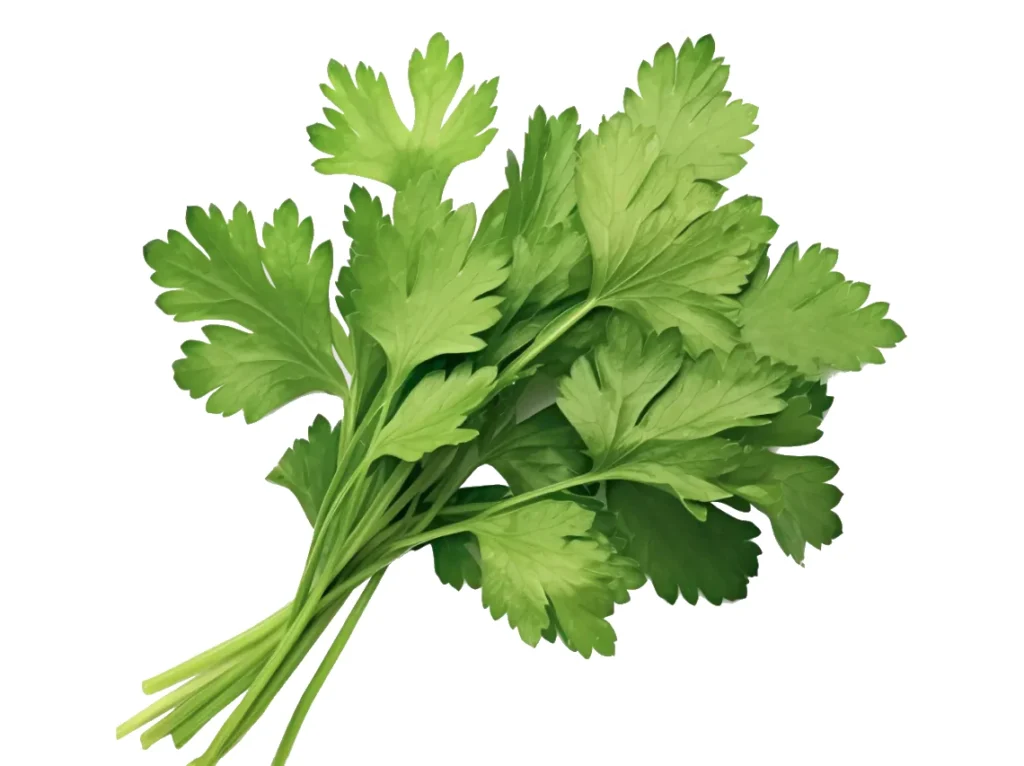
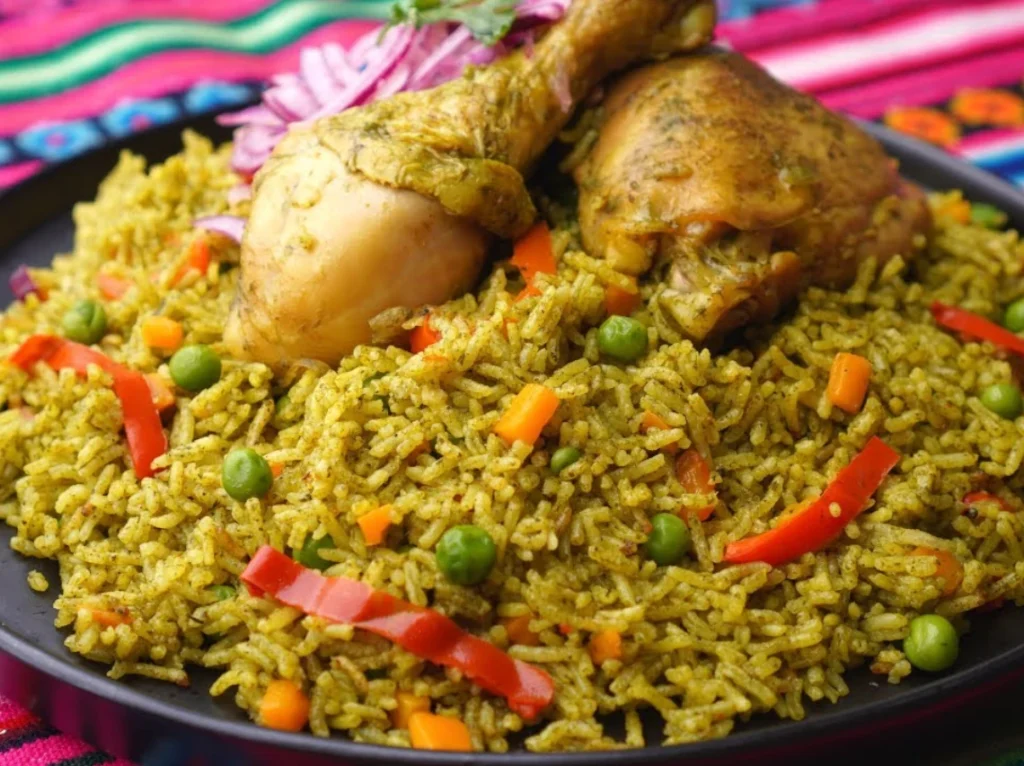
6. Purple Corn: The Soul of Peruvian Refreshment
Purple corn, native to the Peruvian Andes, has been cultivated since pre-Columbian times. This corn is known not only for its vibrant color but also for its medicinal properties. The ancient Incas used purple corn to make drinks like chicha morada, famous for its antioxidant and anti-inflammatory benefits. In Peru, purple corn is a key ingredient in both beverages and desserts.
Nutritional Value and Flavor
Purple corn is rich in anthocyanins, antioxidant compounds that give it its characteristic color and offer numerous health benefits, such as reducing inflammation and improving blood circulation. It also contains a good amount of fiber and vitamins A and C.
In terms of flavor, purple corn has a mildly sweet profile, which is used in traditional drinks and sweets. It is the key ingredient in chicha morada, a refreshing drink enjoyed throughout Peru.
Where to Use It?
Purple corn is a versatile ingredient found in both sweet and savory dishes. Here are a few examples:
- Chicha Morada: A refreshing drink made with purple corn, pineapple, cinnamon, and cloves.
- Mazamorra Morada: A traditional Peruvian dessert that combines purple corn, fruits, and sugar to create a delicious gelatinous mixture.
- Soups and Sauces: Purple corn can also be used as a base for thick sauces and soups.
Where to Find It and Why Use It?
Purple corn can be found in Latin product stores or specialty Peruvian supermarkets. Its unique flavor and antioxidant properties make it an excellent addition to your kitchen, both for its nutritional benefits and its ability to add color and flavor to beverages and desserts.
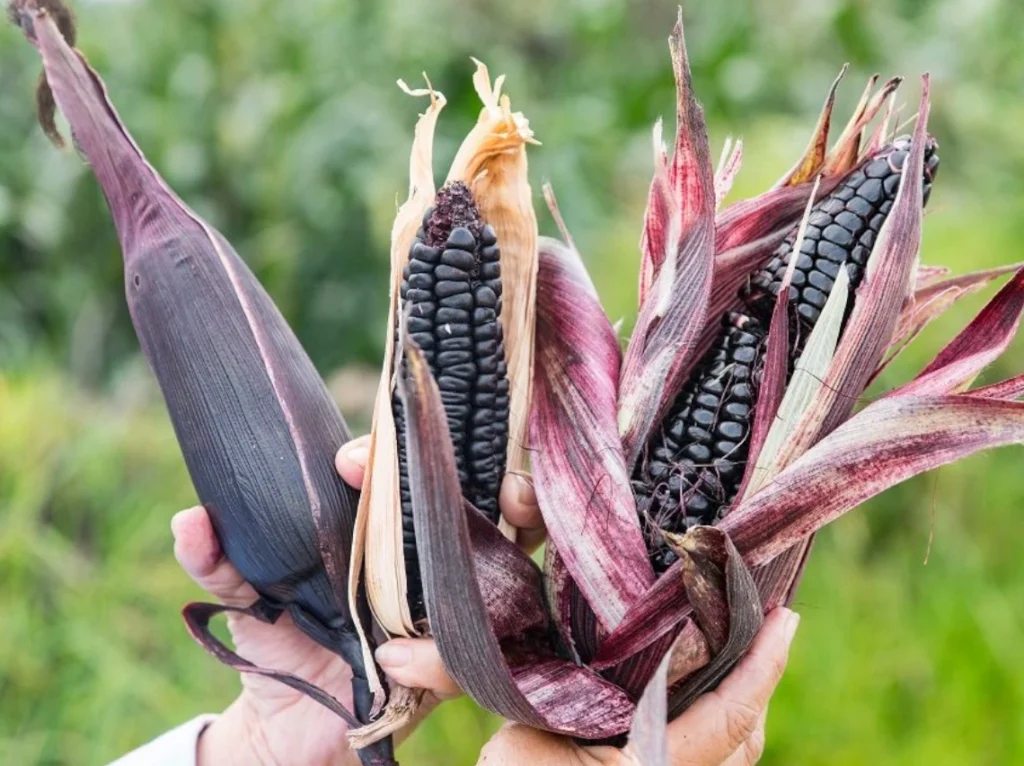
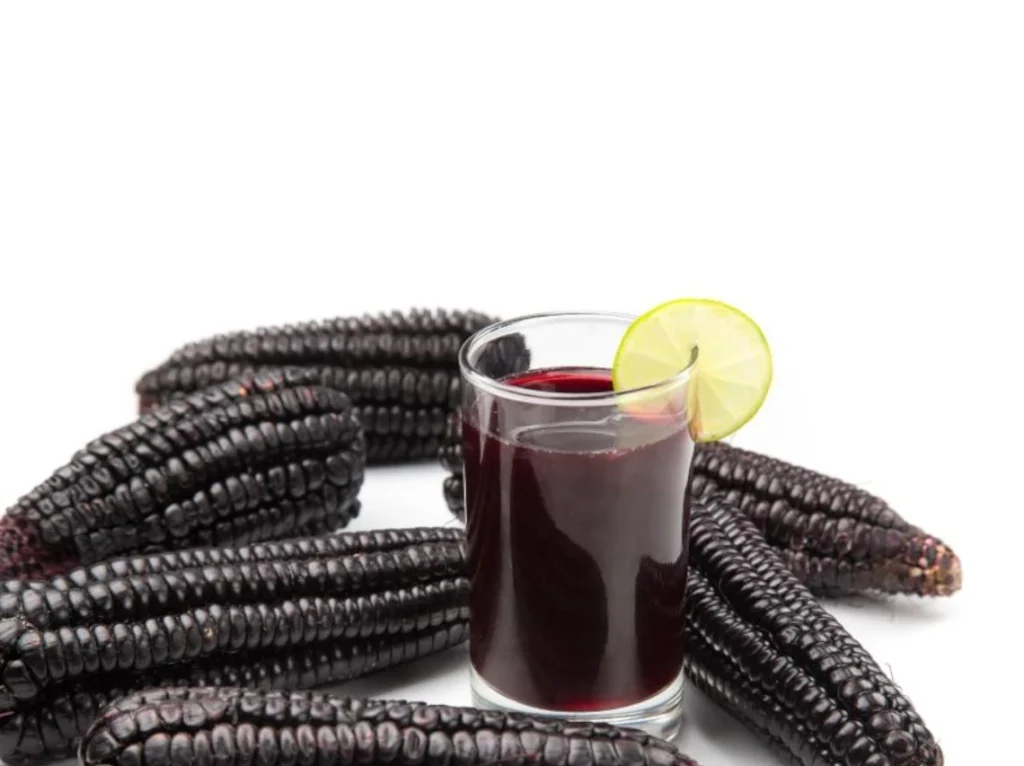
7. Huacatay: The Andean Mint of Freshness
Huacatay, also known as Tagetes minuta, is a plant native to the Andes, used both in gastronomy and traditional medicine. It is a common ingredient in Peruvian cuisine, particularly in dishes that require a touch of freshness and bold flavor. Its use dates back to ancient Andean civilizations, who utilized it not only in cooking but also for its healing properties.
Nutritional Value and Flavor
Huacatay is rich in antioxidants and has anti-inflammatory properties. It is especially known for its ability to aid digestion and improve blood circulation. In terms of flavor, huacatay has a unique profile, with notes of mint, basil, and anise, making it a very special condiment.
Where to Use It?
Huacatay is primarily used in meat dishes, soups, and sauces. Here are some examples of its use:
- Pollo al Huacatay: A chicken dish seasoned with huacatay, garlic, and other traditional Peruvian ingredients.
- Ajiaco de Camarones: A thick soup made with shrimp, potatoes, and huacatay, perfect for cold days.
- Pachamanca: Huacatay is a key herb in the marinade for meats in pachamanca, a traditional Peruvian dish.
Where to Find It and Why Use It?
Huacatay can be found in stores specializing in Peruvian products or Latin markets. Its bold flavor and unique profile make it an essential ingredient to add a special twist to your dishes.
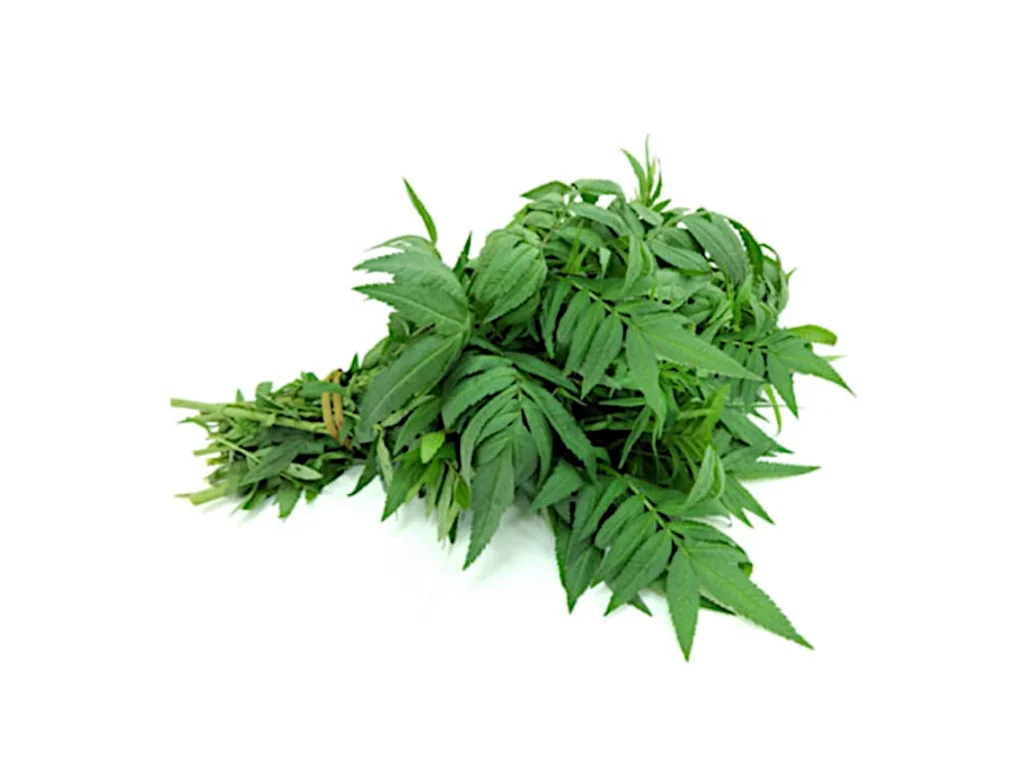
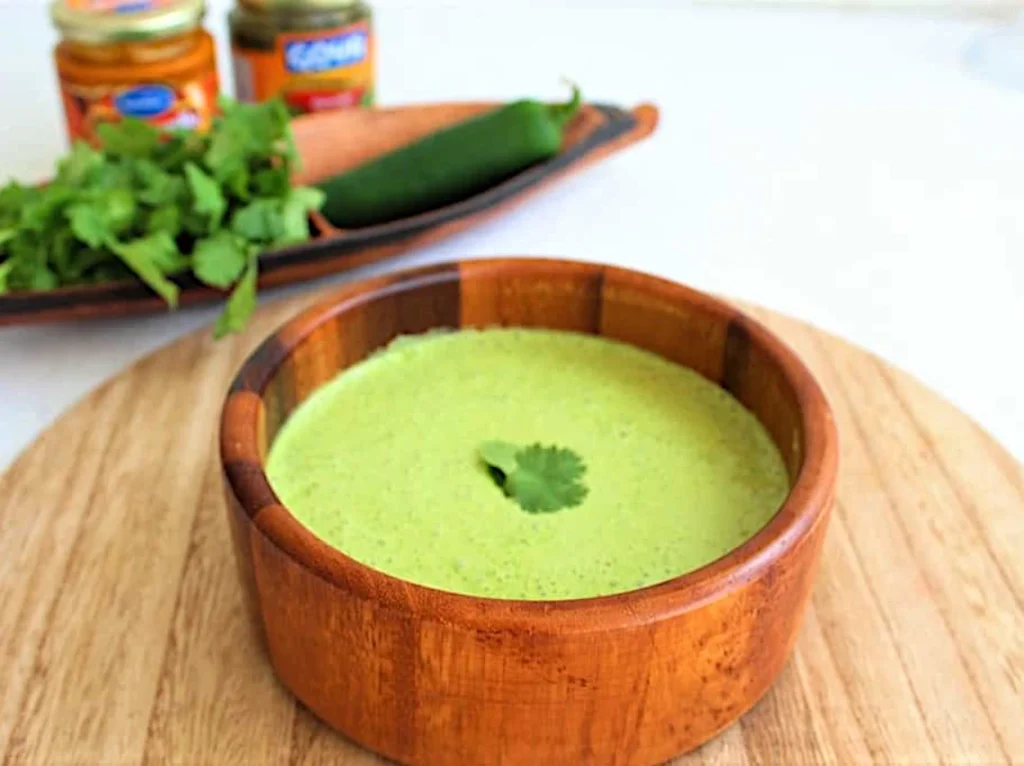
Peruvian cuisine is a reflection of its culture: rich, diverse, and full of stories. Each of these ingredients holds a special place in the hearts of Peruvians, and with a little creativity, they can find a place in your kitchen too.
“Cooking with Peruvian ingredients is not just about preparing a meal, it’s about telling a story. It’s about savoring the Andes, the coast, and the jungle all in one dish.”
Feeling inspired to experiment with these ingredients? Let us know in the comments which ones you already know and which ones you’d like to try.
Don’t forget to subscribe to our newsletter for more stories and recipes directly to your inbox. And, of course, share this article on your social media so more people can discover it.


